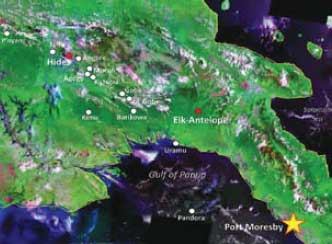What’s new in exploration
Papua New Guinea emerging as a natural gas province In March 2009, InterOil Corp.’s Antelope-1 well in Papua New Guinea (PNG) flowed 382 MMcfd and 5,000 bcpd on a production test (see cover). This may be the world’s highest flowrate for a single well—it certainly set a new record for the island nation that lies 250 mi north across the Coral Sea from Australia. Several giant gas fields have been discovered there since the late 1980s, but the Antelope-Elk discovery opens a new play area in the eastern part of the Papuan Basin. Here, Tertiary carbonate reservoirs are the objective, in contrast to Mesozoic sandstone reservoirs in the western basin area. Antelope and other recent discoveries could make PNG an important exporter of LNG in the near-future. Three flare tests were conducted on the Antelope-1 well through unrestricted 7-in. production tubing at rates of 169, 225 and 382 MMcfd, along with associated condensate, from Upper Oligocene-Upper Miocene carbonate reservoirs. The tested interval was from 5,732 ft to 7,874 ft, with a bottomhole pressure of 3,546 psi (slightly over-pressured). A 2,028-ft gas column is inferred from correlation with the nearby Elk-1 and Elk-2 wells drilled on the same structure. The accumulation was discovered in 2006 when the Elk-1 well tested 21.7 MMcfd from 620 ft of fractured, low-porosity carbonate mudstones in the Puri and Mendi formations. The discovery was confirmed by the Elk-2 well in August 2007 in a similar reservoir facies. In May 2008, the Elk-4 well tested 105 MMcfd and 1,890 bcpd from a shallow-water marine limestone section with better reservoir quality than was found previously. The Antelope-1 well was spudded in October 2008 to test the highest point on the Elk-Antelope structure, and a reef reservoir facies that was interpreted from seismic data. The carbonate reservoir was penetrated 1,595 ft higher than in the Elk-4 well due to stratigraphic thickening of the reef interval. Sample examination, wireline logs and 188 side-wall cores confirmed the reservoir interpretation and indicated almost 100% dolomitization of the upper part of the reef sequence.
While drilling, gas flowed to the surface at a rate of 15 MMcfd and mud losses suggested high permeability. InterOil estimated 90% net-to-gross pay across the 2,300-ft reservoir section. The dolomite has an average porosity of 13.1% and the limestone averages 6.6%. InterOil estimates that most-likely recoverable gas contingent resources from Elk-Antelope are 6.1 Tcf. Source rocks are found in both Jurassic and Cretaceous-Tertiary shales. Geochemical analysis indicates that the main source interval is the Late Cretaceous to Early Tertiary Ieru, Chim and Pale shales that underlie the carbonate reservoir. Sourcing for oil and gas production in the western part of the basin (Papuan Fold Belt—PFB) is believed to come from the older Jurassic Imburu and Maril shales. All reservoirs in the western PFB are Cretaceous. Hides is the largest PNG field and is located in the western PFB about 160 mi northwest of Elk-Antelope Field. Discovered in 1987 by BP, it is a large anticlinal trap with 5.3 Tcf of recoverable gas reserves in the Cretaceous Toro and Digimu sandstones. InterOil has identified other structural objectives with possible reef reservoir facies that, together with Antelope-Elk Field, potentially have resources of 11 Tcf. There are 14 Tcf of proved reserves from fields in the western PFB, and as much as 38 Tcf of possible resources in the basin based on current prospect inventories. Most of this gas is stranded except for a small amount used for electricity generation by local mines. A consortium of operators in the western PFB is moving toward an agreement to process and transport LNG. While the new discovery is the first commercial petroleum production from carbonate reservoirs, much of the earliest exploration activity in the basin was in the eastern PFB and involved carbonate objectives. The first discovery in the basin was at Kuru in 1956. The well blew out in Tertiary carbonate reservoirs, and Red Adair brought the well under control four months later. InterOil plans to build a 220-mi pipeline along the coast to Napa Napa near Port Moresby, where the company envisions a 6−9 MMt/y (0.8−1.2 Bcfd) LNG plant and LPG export terminal. The company estimates a project cost of US$4−5 billion and has sold a 20.5% interest in Elk-Antelope Field to Petromin, the state oil company of PNG, to raise cash. The high condensate volume at Elk-Antelope should provide favorable economics from NGL-stripping. InterOil already operates a 36,000 bopd refinery in PNG and supplies 100% of the domestic market for fuel products. InterOil’s Elk-Antelope discovery, along with RiftOil’s recent Puk Puk and Douglas discoveries in the western PFB (729 Bcf EUR and a 200 MMcfd production test at Puk Puk), have captured worldwide attention with extraordinarily high flowrates and expectation of additional discoveries. LNG has great promise as a global resource, but it also has a long history of construction delays, cost overruns and unfulfilled expectations. Global liquefaction capacity may finally overcome past bottlenecks in 2009, and international contracts for LNG are approaching competitive market prices. At the same time, demand for LNG is down because of the global recession, and the need for additional capacity is unclear. Still, the Elk-Antelope discovery is a hopeful sign in a worldwide exploration arena that is increasingly dominated by small and dynamic independent E&P companies.
|
||||||||
- Shale technology: Bayesian variable pressure decline-curve analysis for shale gas wells (March 2024)
- Quantum computing and subsurface prediction (January 2024)
- Machine learning-assisted induced seismicity characterization of the Ellenburger formation, Midland basin (August 2023)
- EOR/IOR technology: Advanced shale oil EOR methods for the DJ basin (May 2023)
- Regional report: South Australia: New life in a mature basin: S.A.’s Cooper basin CCS and exploration opportunities (May 2023)
- The last barrel (April 2023)





